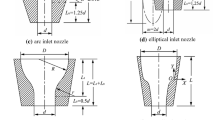Abstract
This paper presents analysis and optimization of a liquamatic fire water monitor with a novel self-swinging mechanism. The design of the self-swinging mechanism has adopted a four-bar linkage driven by an impeller. The Fluent software was used to simulate the internal flow performance of the fire water monitor. In particular, the effects of the cross-sectional shape, diameters of the monitor body, inlet water pressure, and drive set of the self-swinging mechanism on the jet characteristics were analyzed. These analyses have led to optimal structural parameters of the flow channel. A prototype of the fire ware monitor was manufactured, and the field test was performed. Both simulation analyses and experimental results are expected to provide useful good guidance for the design of other types of fire water monitor.
Similar content being viewed by others
References
Chen T, Yuan HY, Su GF, Fan WC (2004) An automatic fire searching and suppression system for large spaces. Fire Saf J 39(4):297–307
Cui LL, An LQ, Gong WL, Jiang HJ (2007) A novel process for preparation of ultra-clean micronized coal by high pressure water jet comminution technique. Fuel 86(5–6):750–757
De Wrachien D, Lorenzini G (2006) Modelling jet flow and losses in sprinkler irrigation overview and perspective of a new approach. Biosyst Eng 94(2):297–304
Gao J, Zhang R, Cao GQ, Zhang GM (2009) The model analysis of molding sand's removal and mechanism research using high pressure water-jet technique. Appl Mech Mater 16–19:1127–1132
Guo TN, Fu ZM (2007) The fire situation and progress in fire safety science and technology in China. Fire Saf J 42(3):171–182
Hu GL, Chen WG (2010) Hydraulic performance research of a fixed fire water monitor. Adv Mater Res 97–101:2792–2796
Hu GL, Chen WG, Gao ZG (2010) Flow analysis of spray jet and direct jet nozzle for fire water monitor. Adv Mater Res 139–141:913–916
Hu GL, Chen WG, Zhou XJ (2009) Design and simulation analyses of fixed fire water monitor. Proceedings of the Seventh International Conference on Fluid Power Transmission and Control, ICFP'2009, pp 720–723.
Hu GL, Gao ZG (2010) Design and numerical simulation of the liquamatic fire water monitor with vavle-controlled cylinder device. The International Workshop on Mechanic Automation and Control Engineering, MACE'2010, pp 2524–2527
Hu GL, Gao ZG (2011) Dynamic characteristics research of self-swinging control system with valve-controlled cylinder device for liquamatic fire water monitor. Appl Mech Mater 44–47:1427–1431
Jun F, Ji J, Yuan HY, Zhang YM (2006) Early fire smoke movements and detection in high large volume spaces. Build Environ 41(11):1482–1493
Kulekci MK (2002) Processes and apparatus developments in industrial waterjet applications. Int J Mach Tool Manufact 42(12):1297–1306
Perrig A, Avellan F, Kueny JL, Farhat M, Parkinson E (2006) Flow in a Pelton turbine bucket: numerical and experimental investigations. Journal of Fluid Engineering 128(2):350–358
Rose-Pehrsson SL, Hart SJ, Street TT, Williams FW, Hammond MH, Gottuk DT, Wright MT, Wong JT (2003) Early warning fire detection system using a probabilistic neural network. Fire Technol 39(2):147–171
Santolin A, Cavazzini G, Ardizzon G, Pavesi G (2009) Numerical investigation of the interaction between jet and bucket in a Pelton turbine. Proc IME J Power Energ 223(A6):721–728
United States (2001) Patent 6,305,620 B1, Patented Oct.23
United States (2007) Patent 7,191,964 B2, Patented Mar.20
United States (2010) Patent 7,644,777 B2, Patented Jan.12
Wang HH, Fan WC (1997) Progress and problems of fire protection in China. Fire Saf J 28(3):191–205
Yan HJ, Bai G, He JQ, Li YJ (2010) Model of droplet dynamics and evaporation for sprinkler irrigation. Biosyst Eng 106(4):440–447
Yang FC, Shiah SW, Heh TY (2009) The effect of orifice lead cutting edge distance and fluid viscosity on jet performance in high-velocity waterjet cutting systems. Int J Adv Manufact Technol 40(3):332–341
Yang LZ, Zhou XD, Deng ZH, Fan WC, Wang QA (2002) Fire situation and fire characteristic analysis based on fire statistics of China. Fire Saf J 37(8):785–802
Zhang Z (2007) Flow interactions in Pelton turbines and the hydraulic efficiency of the turbine system. Proc IME J Power Energ 221(A3):343–358
Zhang Z (2009) Inlet flow conditions and the jet impact work in a Pelton turbine. Proc IME J Power Energ 223(A5):589–596
Zhang Z (2009) Flow dynamics of the free surface flow in the rotating buckets of a Pelton turbine. Proc IME J Power Energ 223(A5):609–622
Zhong MH, Fan WC, Liu TM, Zhang PH, Wei X, Liao GX (2004) China: some key technologies and the future developments of fire safety science. Saf Sci 42(7):627–637
Author information
Authors and Affiliations
Corresponding authors
Rights and permissions
About this article
Cite this article
Hu, G., Long, M., Liang, J. et al. Analysis of jet characteristics and structural optimization of a liquamatic fire water monitor with self-swinging mechanism. Int J Adv Manuf Technol 59, 805–813 (2012). https://doi.org/10.1007/s00170-011-3508-y
Received:
Accepted:
Published:
Issue Date:
DOI: https://doi.org/10.1007/s00170-011-3508-y




